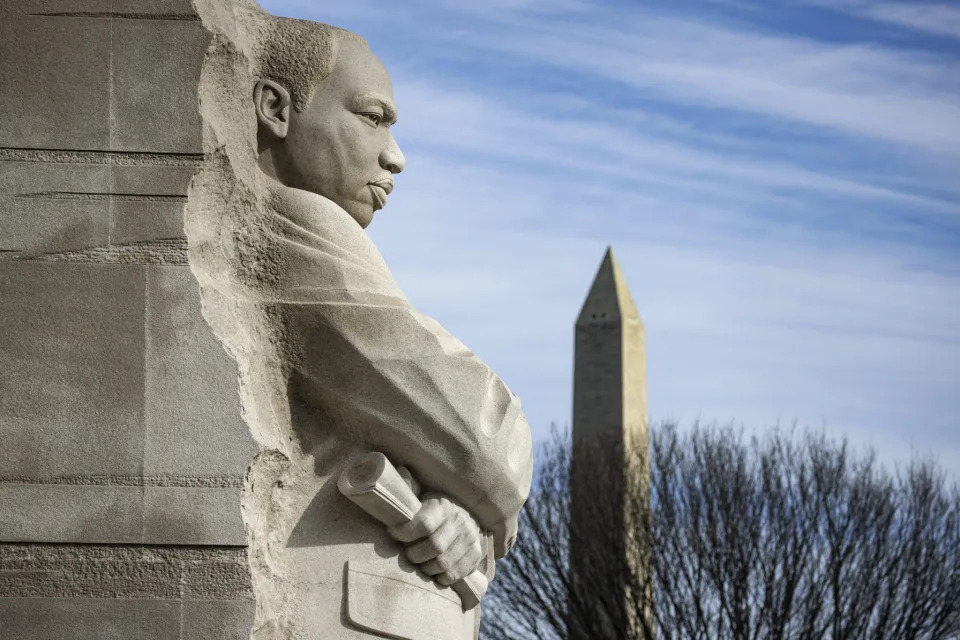Rachel Ramirez, CNN
Tue, January 16, 2024

If you’ve been on YouTube lately, you might have come across someone claiming wind and solar energy don’t work, that rising sea levels will help coral reefs flourish, or that climate scientists are corrupt and alarmist.
These are all false and misleading statements taken from a handful of thousands of YouTube videos analyzed by the nonprofit Center for Countering Digital Hate (CCDH), which has identified a stark change in the tactics of climate deniers over the past few years.
Where once climate deniers would outright reject climate change as a hoax or scam, or claim that humans were not responsible for it, many are now shifting to a different approach, one which attempts to undermine climate science, cast doubt on climate solutions and even claim global warming will be beneficial at best, harmless at worst.
The past five years have seen a “startling” rise in this “new denial,” according to a CCDH analysis published Tuesday, which also suggests this shift in narrative could also be helping YouTube video creators circumvent the social media company’s ban on monetizing climate denial.
Researchers gathered transcripts from more than 12,000 videos posted between 2018 and 2023 across 96 YouTube channels that have promoted climate denial and misinformation. Transcripts were analyzed by artificial intelligence to categorize the climate denial narratives used as either “old denial” or “new denial.”
“New denial” content — attacks on solutions, the science and the climate movement — now makes up 70% of all climate denial claims posted on YouTube, according to the report, up from 35% in 2018.
Classic “old denial” claims that global warming isn’t happening declined from 48% of all denial claims in 2018 to 14% in 2023, the report found. Claims that climate solutions won’t work, however, soared from 9% to 30% over the same period.
Imran Ahmed, chief executive officer and founder of CCDH, said the report in some ways is a story of success.
“The climate movement has won the argument that climate change is real, and that it is hurting our planet’s ecosystems,” he told CNN. As the impacts of the climate crisis — from scorching heat waves to fierce storms — affect a broader swath of the global population, narratives that deny the existence of climate change are becoming less effective.
But, he added, it’s also a huge warning. “Now that the majority of people recognize old climate denial as counterfactual and discredited, climate deniers have cynically concluded that the only way to derail climate action is to tell people the solutions don’t work.”
“This new climate denial is no less insidious,” Ahmed said, “and it could hold enormous influence over public opinion on climate action for decades to come.”
It’s particularly worrying because of the young demographic attracted to YouTube, according to the CCDH. A December survey from Pew Research Center found YouTube to be the most widely used social media platform it analyzed among 13- to 17-year olds, used by roughly nine in 10 of them.
“Climate deniers now have access to vast global audiences through digital platforms,” Charlie Cray, senior strategist at Greenpeace, said in a statement. “Allowing them to steadily chip away at public support for climate action — especially among younger viewers — could have devastating consequences for the future of our planet.”
The shift in tactics to undermine climate action could also help creators get around YouTube’s policy banning them from making money on climate denial content, the report suggests. In 2021, the company prohibited advertising against content that “contradicts well-established scientific consensus around the existence and causes of climate change.”
Yet YouTube is potentially making up to $13.4 million a year from ads on videos the report found to contain climate denial, according to the CCDH’s calculations, including ads from prominent sportswear companies, hotels and international nonprofits.
“There aren’t many companies that would be happy about seeing their advertising appear next to clear climate denial content,” Ahmed said. “And I imagine they will be furious to find out that they are inadvertently funding climate denial content.”
In a statement to CNN, a YouTube spokesperson said, “debate or discussions of climate change topics, including around public policy or research, is allowed.”
However, the spokesperson added, “when content crosses the line to climate change denial, we stop showing ads on those videos. We also display information panels under relevant videos to provide additional information on climate change and context from third parties.”
YouTube said its enforcement teams work quickly to review videos that may potentially violate policies, then act on them.
The company said that after reviewing the CCDH report, it found some of the videos included did violate existing climate change policies and has since removed ads from them. However, it also said the majority of the videos in the analysis did not breach their policies.
Michael Mann, a leading climate scientist at the University of Pennsylvania who has studied the narrative shift in climate denial, said the findings were “disturbing.”
“It is extremely unlikely that this is the result of organic social media activity,” Mann, who was not involved in the study, told CNN. “It suggests that bad actors have made a concerted effort to weaponize social media in a way that is especially targeted toward young people, recognizing that they are the greatest threat to the fossil fuel industry status quo, as evidenced by the tremendous impact of the youth climate movement.”
Ahmed called on Google to boost its policies to deal with “new denial” content. “We’re asking Google to extend their ban on monetization and amplification of ‘old denial’ content to include ‘new denial’ as well,” Ahmed said, adding that other social media companies should also take note of the report’s findings.
“We’re asking other platforms that claim to be green in one breath not to profit from, to revenue share, and therefore, reward or to amplify clear climate denial content that contradicts scientific consensus,” Ahmed added. “You can’t claim to be green but then be the world’s biggest megaphone for climate change-related disinformation.”
Climate denial is evolving on YouTube, report says, as third of UK teens think crisis is exaggerated
Lottie Limb
Tue, January 16, 2024

Climate denial is evolving on YouTube, report says, as third of UK teens think crisis is exaggerated
Teenagers are being influenced by a new breed of climate denial content on YouTube, a campaign group has warned.
Almost a third of 13-17 year olds in the UK think that climate change is being “purposefully over-exaggerated”, according to a survey commissioned by the Center for Countering Digital Hate (CCDH).
A new report from the big tech watchdog investigates how climate denial is shared on YouTube - teens’ favourite social media platform. It comes days after the World Economic Forum’s Global Risks Report warning that misinformation and disinformation are the biggest short-term risks to global security.
“Platforms like YouTube have developed technology to monopolise young people's attention and shouldn’t direct that towards climate denial,” says Michael Khoo, Climate Disinformation Program Director at Friends of the Earth.
‘I am more worried than ever’: Scientists explain why record-shattering 2023 heat has them on edge
What are ‘new climate denial’ narratives?
Researchers from CCDH have seen a pronounced shift in what they term ‘new denial’ narratives around the climate crisis.
Old denial, the group says, was premised on two key false narratives: that global warming is not happening, or that humans are not causing it.
New denial moves along three prevalent lines which claim that: climate solutions won’t work; climate science and the climate movement are unreliable; and the impacts of global warming are beneficial or harmless.
“Scientists have won the battle to inform the public about climate change and its causes, which is why those opposed to climate action have cynically switched focus to undermining confidence in solutions and in science itself,” says CCDH chief executive Imran Ahmed.
CCDH says that these subsequent stories - championed by the likes of Canadian influencer Jordan Peterson - now make up 70 per cent of all climate denial on YouTube, compared to 35 per cent in 2018.
The researchers reached this figure by taking a dataset of text transcripts from more than 12,000 climate-related YouTube videos posted by 96 channels over almost six years, between January 2018 to September 2023. They then used an AI model to analyse the transcripts, categorising them into different forms of denial.
YouTube is ‘making millions’ from climate denial accounts
Google (YouTube’s owner) took a significant step towards disincentivising climate denial content back in October 2021, when it banned ads for - and the monetisation of - such videos.
This was prompted by concerns from advertisers, who naturally did not want their ads running alongside inaccurate claims about climate change.
But CCDH says it found ads for legacy brands like Hilton Hotels and Nike on videos containing climate denial, as well as paid ads by charities like Save the Children.
Its new report makes three big criticisms of YouTube. Firstly, that the social media platform is potentially making up to $13.4 million (around €12,000) a year in ad revenue from channels it studied that have posted climate denial content.
Secondly, YouTube's rules do not cover the new denial claims that are now being heavily pursued by bad faith actors. And thirdly that YouTube is failing to enforce its existing policy against the monetisation of videos promoting ‘old denial’.
“Our climate change policy prohibits ads from running on content that contradicts well-established scientific consensus around the existence and causes of climate change,” a Youtube spokesperson tells Euronews Green in response.
“Debate or discussions of climate change topics, including around public policy or research, is allowed. However, when content crosses the line to climate change denial, we stop showing ads on those videos. We also display information panels under relevant videos to provide additional information on climate change and context from third parties.”
After looking into the content flagged by CCDH, YouTube acknowledges that some of the videos shared violated its climate change policy, and has removed ads from running on them. But, it says, the majority of examples given were policy compliant.
‘Climate deniers are victims not villains’: A psychologist’s guide to winning them over
Two thirds of Brits are struggling with climate anxiety. Here’s what you can do about it
Campaigners urge Google to take greater action as teens affected
As climate denial and delaysim continue to evolve, drawing the line in the right place is a mammoth task for tech giants like Google. But mis- and disinformation campaign groups urge tighter action to be taken.
Particularly concerning, they say, is the impact this kind of content is having on young people.
YouTube is the most widely used social media platform among 13- to 17-year-olds in the US, according to a survey by the Pew Research Center last month. 71 per cent of teens say they use the video-sharing platform daily, including 16 per cent who report being on the site almost constantly.
Polling conducted by Survation for the CCDH in March 2023, meanwhile, found that 31 per cent of UK respondents aged 13-17 agreed with the statement “Climate change and its effects are being purposefully over exaggerated”.
This rose to 37 per cent of teens who were ‘heavy users’ of social media, meaning they reported using any one platform for more than four hours a day. Just over 1,000 children were surveyed for the poll via online interviews.
“It is time for digital platforms to put their money where their mouth is. They should refuse to amplify or monetise cynical climate denial content that undermines faith in our collective capacity to solve humanity’s most pressing challenge,” says CCDH chief executive Ahmed.
“We've pressured Google to stop supporting climate denial in the past, but they've done little,” adds Friends of the Earth’s Khoo. “The New Climate Denial report shows a disturbing shift in the tactics used by bad actors to derail the action needed to avert further disaster."
YouTube making money off new breed of climate denial, monitoring group says
Reuters
Tue, January 16, 2024

Illustration shows YouTube logo
(Reuters) - YouTube is making millions of dollars a year from advertising on channels that make false claims about climate change because content creators are using new tactics that evade the social media platform's policies to combat misinformation, according to a report published on Tuesday.
The Center for Countering Digital Hate (CCDH) used artificial intelligence to review transcripts from 12,058 videos from the past six years on 96 of Alphabet Inc's YouTube channels. The channels promoted content that undermines the scientific consensus on climate change that human behavior is contributing to long-term shifts in temperature and weather patterns, the report said.
CCDH, a nonprofit that monitors online hate speech, said its analysis found that climate denial content has shifted away from false claims that global warming is not happening or that it is not caused by greenhouse gases produced from burning fossil fuels. Videos espousing such claims are explicitly banned from generating ad revenue on YouTube, according to Google's policy.
Instead, the report found that last year 70% of climate denial content on the channels analyzed focused on attacking climate solutions as unworkable, portraying global warming as harmless or beneficial, or casting climate science and the environmental movement as unreliable. That's up from 35% five years earlier.
"A new front has opened up in this battle," Imran Ahmed, chief executive of CCDH, said on a call with reporters. "The people that we've been looking at, they've gone from saying climate change isn't happening to now saying, 'Hey, climate change is happening but there is no hope. There are no solutions.'"
YouTube is making up to $13.4 million a year from ads on the channels that the report analyzed, CCDH said. The group said the AI model was crafted to be able to distinguish between reasonable skepticism and false information.
In a statement, YouTube did not comment directly on the report but defended its policies.
"Debate or discussions of climate change topics, including around public policy or research, is allowed," a YouTube spokesperson said. "However, when content crosses the line to climate change denial, we stop showing ads on those videos."
CCDH called on YouTube to update its policy on climate denial content and said the analysis could assist the environmental movement to combat false claims about global warming more broadly.
(Reporting by Nichola Groom; Editing by Leslie Adler)


















